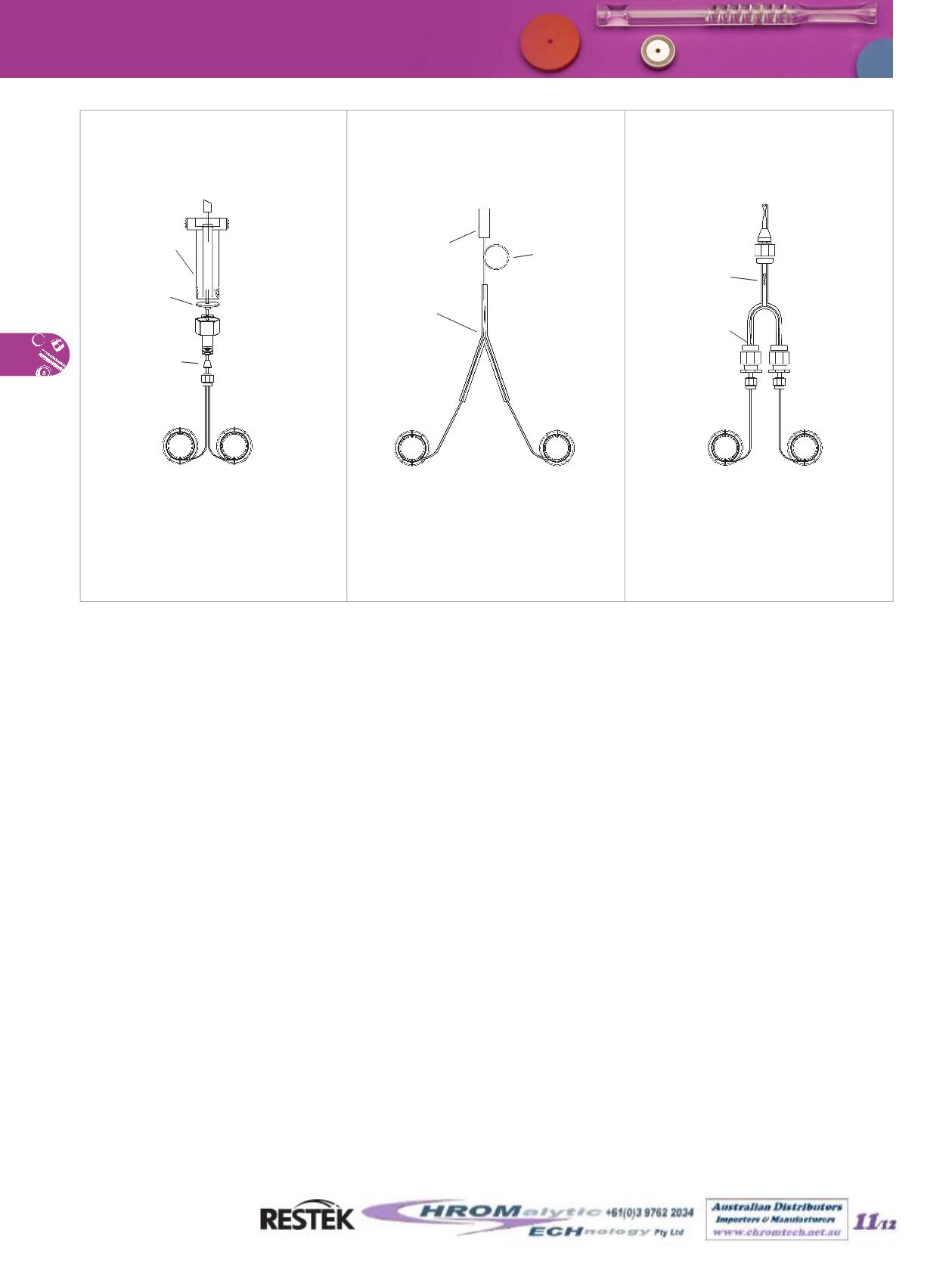
268
GC ACCESSORIES |
INSTRUMENT SUPPLIES
Dual Column Analysis
two-hole
ferrule
Dual Column Analysis: Which technique is right for you?
Two-hole ferrules allow dual-column
confirmational analysis in the same
split/splitless inlet.
2 or 4 mm ID
splitless liner
inlet seal
analytical
column
analytical
column
The “Y” Press-Tight® configuration allows dual
columns to be used in either a split/splitless or
direct injection inlet.
0.25 and 0.32 mm ID columns can be used with
standard
1
/
16
-inch inlet fittings (cat. # 27185).
0.53 mm ID columns require
1
/
8
-inch fittings
(cat. # 20645) to allow both columns to fit side
by side in the injector. Use either straight or
extended gooseneck split/splitless liners.
The “Y” Press-Tight
®
configuration offers
versatility because it allows any diameter
column or guard column to be connected to
a split/splitless or direct injection liner.
The direct injection “T” allows two 0.32 or
0.53 mm ID columns to be connected to one
1
/
4
-inch packed column inlet.
cyclo
analytical
column
analytical
column
The direct injection “T” incorporates a glass spiral
to ensure complete vaporization prior to splitting
the sample onto two columns. The dual sealing
mechanisms increase ease of use and confidence
in the connection relative to the “Y” Press-Tight
®
configuration.
Split/Splitless Injection
Direct Injection
Split/Splitless or Direct Injection
Press-Tight
®
taper
*Instrument-specific fittings for performing dual column analyses can be found in the Supplies for Agilent and Supplies for Varian sections.
split/splitless or
direct injection liner
guard column
“Y” Press-Tight
®
analytical
columns
Analyzing the same sample on two columns of different polarity can increase both qualitative and quantitative reliability. However,
having to repeat the analysis on a second column will significantly reduce sample throughput. The simple solution to improving ana-
lytical reliability without reducing sample throughput is to use a simultaneous dual-column technique. This involves connecting two
capillary columns to one GC inlet and connecting each column to its own detection system. Both columns are usually of the same
internal diameter so the flow rates are balanced and similar amounts of the analytes are directed onto each column. This approach
will result in confirmational analysis without reducing sample throughput. Simultaneous dual-column analysis has become a more
routine technique used by laboratories involved with complex analyses in complicated matrices.
Split or Splitless Injectors
Split or splitless injections are the easiest dual-column analyses to perform. Both columns can be inserted into the split/splitless inlet
fitting and terminate in the inlet liner. Columns with internal diameters of 0.32 mm or less (or 0.5 mm OD) can be inserted direct-
ly into the
1
/
16
-inch standard capillary fitting (cat.# 27185, page 269) by using a two-hole capillary ferrule. Columns with internal
diameters of 0.53 mm cannot be inserted into a standard
1
/
16
-inch capillary fitting because the outside column diameter (0.8 mm) is
too large for both to fit simultaneously. Special fittings that use a
1
/
8
-inch fitting and
1
/
8
-inch, two-hole ferrule can be used for 0.53
mm ID column (cat.# 20645, page 269).*
On-Column or Direct Injections
On-column or direct injections require a Press-Tight® connection to the inlet liner. Usually a section of 0.53 mm ID guard tubing is
attached to one leg of a Press-Tight® “Y” connector (cat.# 20405, page 270). Analysts must use columns of equivalent length and ID
so that the flow through both legs of the “Y” is similar, or the detector response will differ. Another approach is to use a Dual Column
Direct Injection Tee (cat.# 20412, page 269) or
mini
-Lam Direct Injection Tee (cat.# 20436, page 269), that is installed into the injec-
tor, with each column connected to the remaining legs of the tee. The Dual Column Direct Injection Tee has a vaporization
chamber to reduce sample backflash and a glass spiral to ensure sufficient vaporization and to reduce discrimination or preferential
splitting. The
mini
-Lam Direct Injection Tee is similar—it incorporates an inverted cup in place of the glass spiral. More informa-
tion on these types of injection tees is given on the facing page.
Website :
E-mail :
TelNo : 03 9762 2034 . . . in AUSTRALIA
Mar 2011


